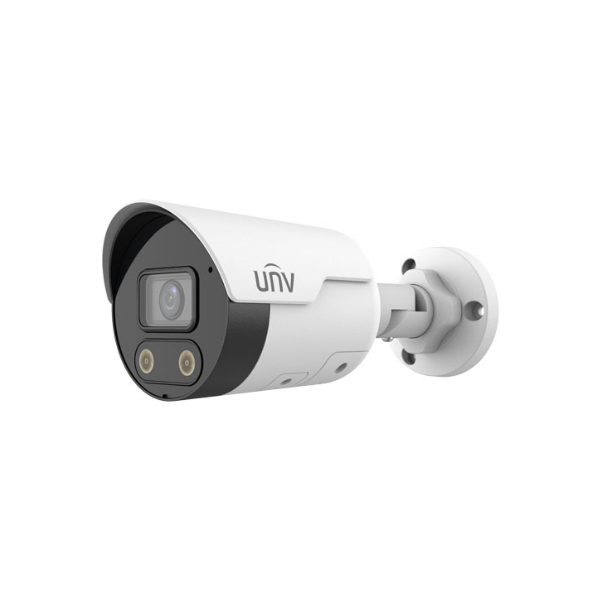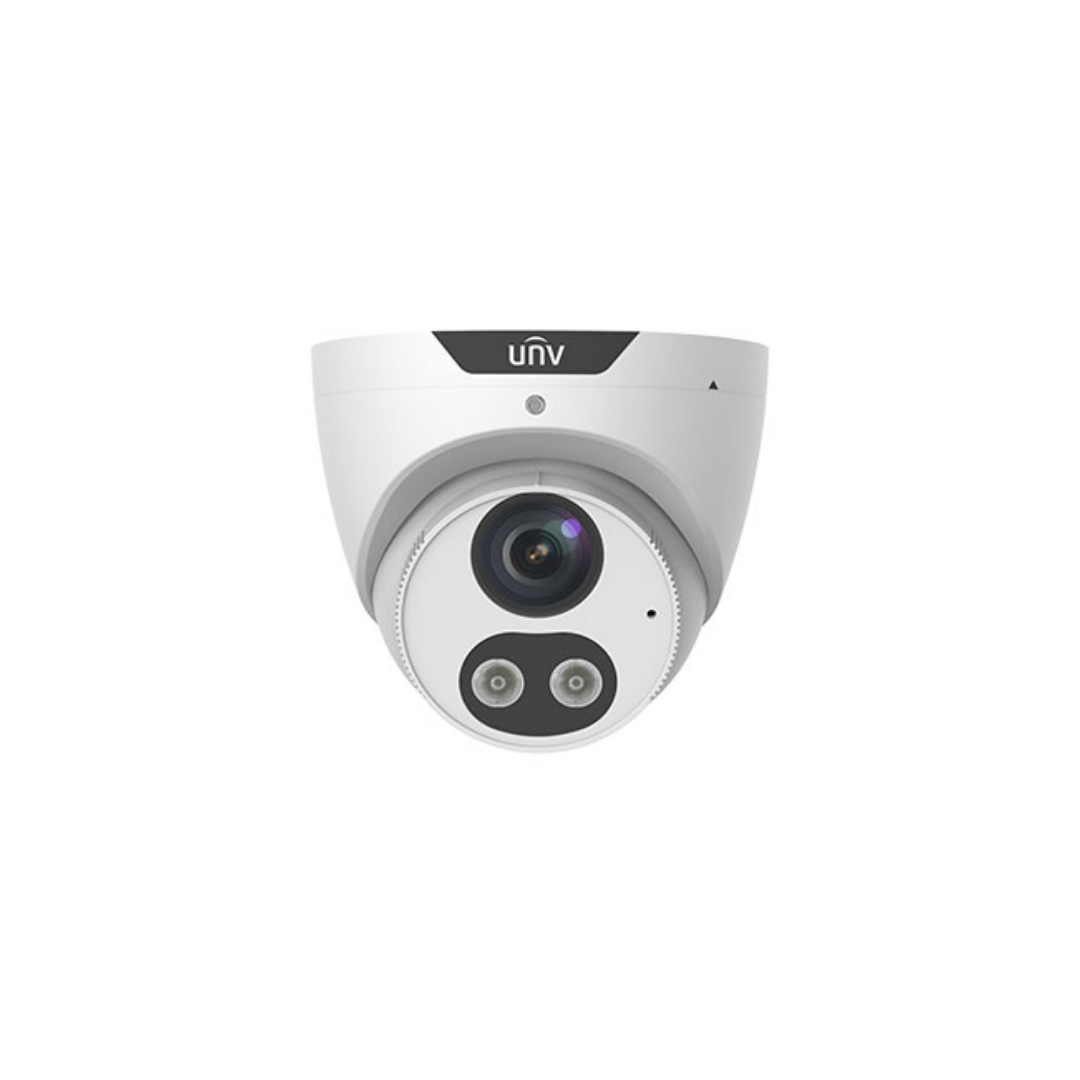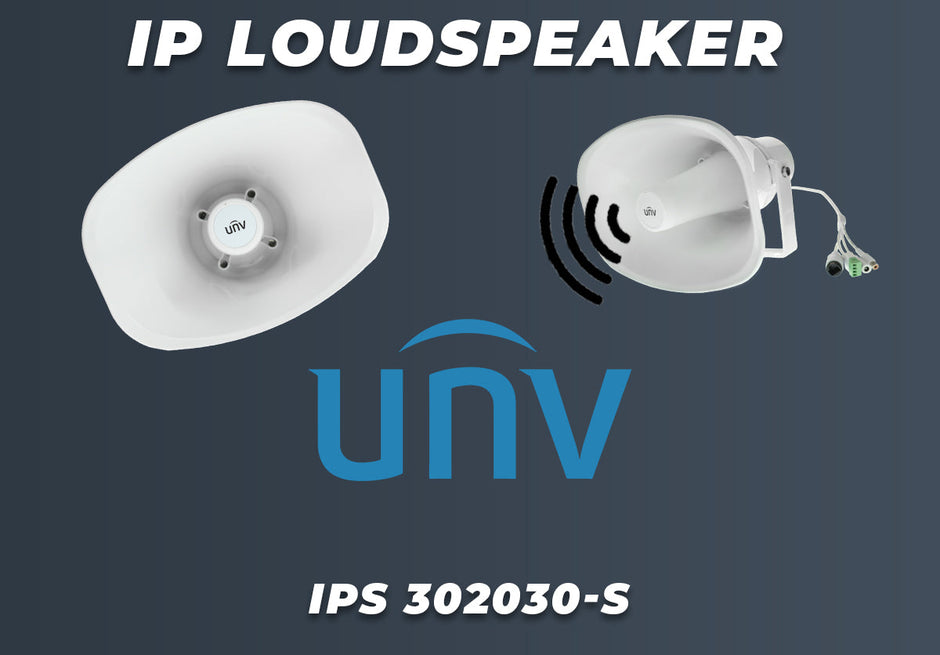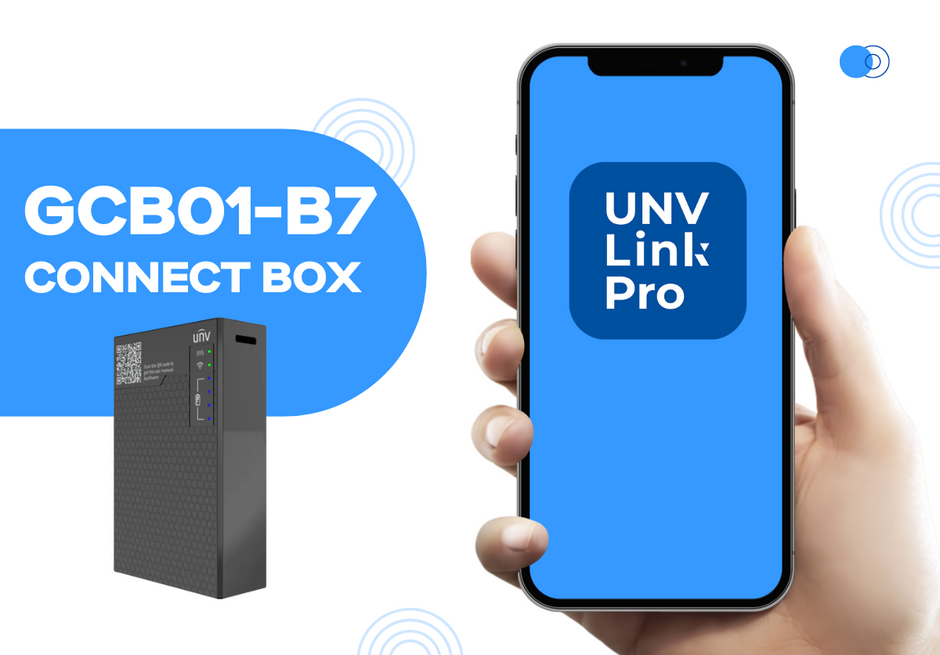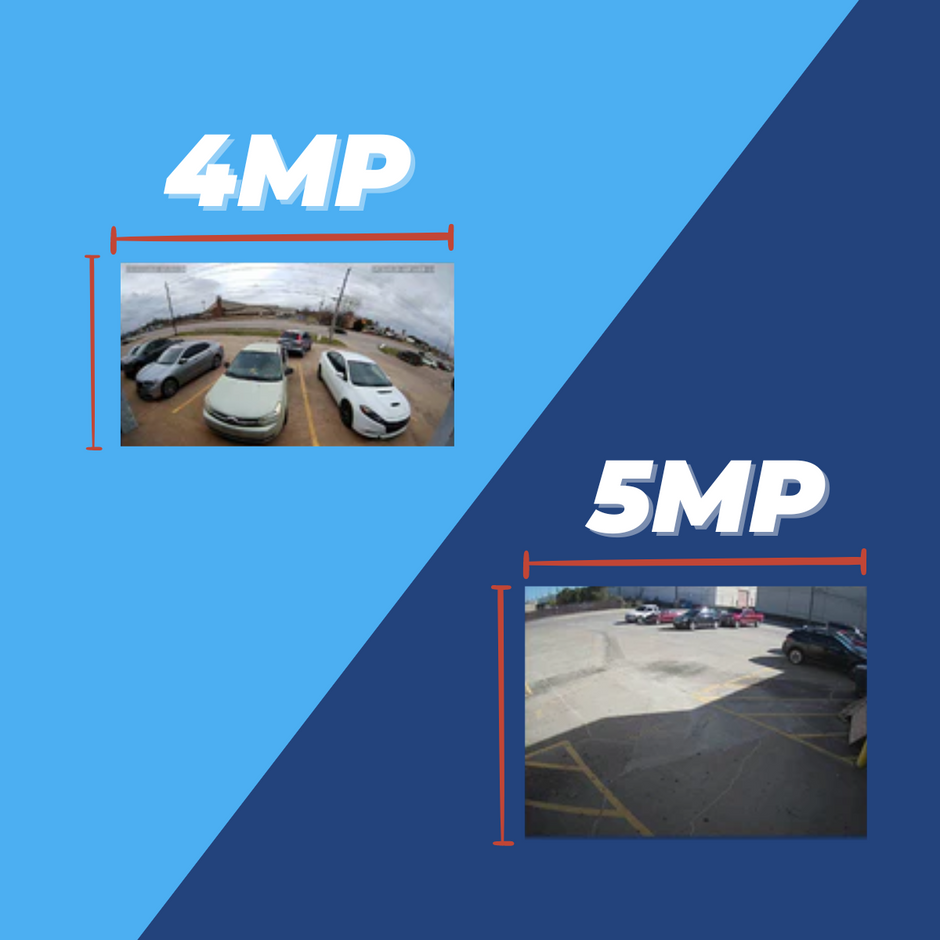Uniview’s Tri-Guard security cameras bring three of Uniview’s greatest features together into one compact, attractive, and powerful camera. Deep Learning Artificial Intelligence, Active Deterrence Lights and Sounds, and ColorHunter 24/7 Color Illumination Technology are incredible features that work great on their own. But when put together, they’re unstoppable.
Get three game-changing features in one with Tri-Guard from Uniview.
A surveillance system is a great tool to have on your property. In fact, our entire business is devoted to making sure individuals and businesses have access to the best video surveillance equipment possible. But it doesn’t matter how powerful a security camera is. On its own, a security camera won’t do anything to prevent crime from happening.
That’s where Uniview’s Tri-Guard comes into play. These security cameras will help you take your video surveillance system from passive to active, from reactive to proactive. How does it work? Well, as the name suggests, there are three main features pulled from other Uniview cameras and bundled into one product. Let’s take a look at each feature individually, and then we’ll see how they can work together to provide a unique and powerful CCTV experience.
Deep Learning Artificial Intelligence
The first main feature of the Tri-Guard camera is Uniview’s Deep Learning Artificial Intelligence. This is an advanced algorithm that allows a security camera to recognize certain types of motion and filter out unimportant motion. You can read more about this algorithm by reading our Deep Learning AI blog post.
What does this mean for you? It’s going to drastically reduce the amount of false alarms you get from your security camera. How?
Traditional Pixel-Based Motion Detection
First, let’s understand how traditional pixel-based security cameras work. The camera is constantly processing video, right? When we look at a camera feed, our eyeballs see one seamless video, but it’s just an illusion.
In reality, the video is made up of a series of frames, and each individual frame is made up of a certain number of square pixels (in the Tri-Guard cameras there are 4,085,760), each a solid color.
As movement happens in the camera’s field of view, the pixels from one frame to another will not have the exact same configuration. When the camera registers this change in pixels across multiple frames, it will trigger a motion detection event.
Standard motion detection determines movement only based on changes in the pixels from frame to frame.
This is great when a potential intruder stumbles onto your property. As a person moves from one side of your yard to the other, the moving pixels will tell your camera that something is going on. Your camera will then do whatever you’ve told it to do at this point, whether that be start a recording, trigger an alarm, or send your phone a push notification.
However, it starts to become less great when you realize that this same process will happen even if a squirrel runs across your property, or if the wind blows a leaf past your camera, or if a spider crawls across the lens, or if a the camera’s IR bounces off of a spec of dust floating nearby. There’s no filtering process to determine if the change in pixels was caused by a human or by literally anything else.
This is a problem because…
- Your NVR will be recording useless footage, taking up precious hard drive space
- Your alarm will constantly be going off for no reason
- Your phone will send you hundreds of push notifications a day letting you know about innocuous movement
- Searching for relevant video surveillance footage will be difficult, since just about every movement that takes place will be tagged as a motion event
In essence, motion detection events will become meaningless. You’ll end up with a ton of footage that you’ll never use. You’ll become deaf to the notifications on your phone, and you’ll probably just end up turning them off.
It’s just like your professor said back in college. If you highlight everything in your textbook, you’re actually highlighting nothing.
Now let’s bring Deep Learning AI into the picture.
Deep Learning Artificial Intelligence
With the Deep Learning AI algorithm, Uniview will take the pixel-based motion detection event and run it through its database to match the motion it detects with motion that it can recognize. With this, it’s able to filter out any movement that isn’t important. The squirrel, the leaf, the spider, the spec. All of that won’t even trigger an event. So what will?
That’s up to you. The Tri-Guard camera has three types of motion that it can recognize: motorized vehicles, non-motorized vehicles, and pedestrians. You can choose one object type or any combination of the three.

With Deep Learning AI, your camera will…
- Save you hard drive space by only recording important movement
- Save you from push-notification overload by only notifying you about important movement
- Make searching through your recorded footage more efficient by giving event tags only to important movement
Setting Up Artificial Intelligence
Since your camera comes with Artificial Intelligence built in, there’s not much you have to do. Anytime you set up an intelligent event, the camera will automatically start filtering out non-important movement. The events will only be triggered based on human or vehicle movement. But you can fine tune the AI to work the way you want it to.
First, pick your intelligent event. There are several for you to choose from:
- Cross line detection
- Area entrance detection
- Area exit detection
- Intrusion detection
- Face detection
- People flow counting
- Crowd density monitoring
Once you’ve selected your event, click the small gear icon to jump into that event’s settings. From here you can adjust the sensitivity of the motion detection, decide which detection object you want your camera to focus on, and adjust the max size of the object. Each of these three settings focus on a different stage in the AI algorithm.

Sensitivity
The sensitivity of your intelligent event ranges from 1 to 100. By default, it’s going to be set to 50. Most of the time, this is going to be sufficient. But if you notice that your event isn’t picking up as much activity as you’d like, or if it’s picking up too much activity, you might want to adjust your sensitivity to dial in your event.

What does adjusting the sensitivity do? It doesn’t actually affect the deep learning AI algorithm. Remember that these intelligent events are still based on pixel movement. As the camera detects pixel changes, it’s going to register movement. Only after the movement is registered will the camera then push that movement through the algorithm to filter out non-important movement. So by adjusting the sensitivity, you’re adjusting the stage right before the AI algorithm kicks in.
If you lower the sensitivity, it’s going to take more change in the pixels for your camera to register motion and send that event into the AI algorithm for filtering. Conversely, if you increase the sensitivity, it’s going to take less of a change in pixels for the camera to register motion.
Again, sensitivity doesn’t change anything with regards to the deep learning algorithm. It only affects what kind of movement gets dumped into the algorithm’s filter.
Detection Object
This setting is where you will tell the camera what you want it to look for: motor vehicle movement, non-motor vehicle movement, or pedestrian movement.
Once the camera detects a change in pixels and registers it as motion, the camera will then move that motion into one of its AI algorithms. The object you choose will determine which AI filter or filters the movement goes into.

Is your camera pointed toward a busy highway and you only want human movement to trigger the event? Only select the “Pedestrian” detection object. Is your camera pointed at a private driveway? You may want to select all three detection objects to act as the AI filter. It’s totally up to you and what you want out of your security camera.
Object Size
Once you’ve determined which object filters you want the camera to use, you can fine tune the algorithm by telling it what size those objects should be. To do this, change the dropdown box to the object size you’d like to edit, then enable either max size, min size, or both.

Once you enable max or min size, you’ll see a green box appear over the camera feed. You can use these boxes to tell the algorithm how large and how small of an object it should look for. By default, the max size is going to be the whole screen and the min size is going to be just 28 x 28 pixels. Again, this is going to be sufficient for most use cases. The camera’s AI is good enough that you don’t usually have to set this. However, if you notice that it’s picking up too much or not enough movement, you can adjust the sizes so that the AI algorithm will know exactly what you’re looking for.
Ready to move your surveillance from passive to active? Get your Tri-Guard cameras today!
Here’s one example of when you might want to use this. As you can see from this image, my camera is pointed at an angle with relation to the street. That means when a car appears on the screen it’s super tiny, but when it exits the screen, it’s much larger. I’ve noticed that when the vehicles are further away from the camera, the AI often mistook them for non-motorized vehicles. Then when the cars got closer, the camera would correct itself. This isn’t a huge issue, because by the time the cars cross the line the camera can tell that they’re motorized vehicles.

But if I wanted to be as precise as possible, I could change the min size of the motorized vehicle and non-motorized vehicle filters to make it so that the camera would ignore the vehicles when they first appear on the screen.
Again, these adjustments are there for when you need them, but this AI algorithm pretty much works out of the box without a whole lot of configuration. With Deep Learning artificial intelligence, your Tri-Guard security camera is smart enough to know the difference between human movement and everything else. This is a great foundation, but it’s not all this camera has in its arsenal. Let’s move onto the next feature: active deterrence.
Active Deterrence Lights & Sounds
As we mentioned at the beginning of this blog post, security cameras are passive by default. They sit idly by, watching and recording whatever they see. But they don’t do anything to actively prevent crime from taking place.
But Tri-Guard cameras aren’t your standard security cameras. Alongside their deep learning AI algorithm, Tri-Guard cameras also come with excellent active deterrence features. When the camera detects human or vehicle movement (or whatever you told the deep learning AI to watch for), it will sound a vocal warning and flash its on-board strobe lights to let people know that they’re being recorded.


With these features, you’ll take your surveillance system from passive to active. Let’s take a closer look at each of these active deterrence features.
Active Deterrence Sounds
There are 12 sounds built into the camera by default:
- You are in the alert area! Please leave!
- You are in the danger zone! Do not approach!
- Please be aware! You are in the monitored area!
- No parking! Please leave!
- Private area! Do not enter!
- Danger! Deep Water!
- Danger! Do not climb!
- Welcome!
- Warning!
- The area is crowded! Please leave!
- Please stop! No more people allowed!
So out of the box, Tri-Guard cameras are ready for pretty much any situation you have in mind. Need to monitor a no parking zone? Want to keep a close eye on crowd density? Setting this up in a dangerous area or a high-crime zone? There’s a sound for that.

But what if you’re setting this up for a unique situation where none of these sounds really make sense? That’s no problem, because you can also add your own sounds. There are a couple of ways to do this.
Adding Sounds from the Web Browser
First, you can upload your MP3 files directly to the camera through the web interface. Navigate to Setup > Video & Audio > Audio > Audio File. Click Browse at the top of the page and import your audio file into the camera.
Requirements:
- Must be PCM or MP3
- Size cannot exceed 200K
Upload anything you’d like, as long as it meets these requirements. Yes, that means you can now Rick Roll anyone that comes onto your property. You’re welcome.
Adding Sounds from the Mobile App
If you don’t want to have to deal with files and file sizes, a much easier way to add sounds to the camera is through the EZView mobile app. With this feature, you can speak directly into your phone or utilize Uniview’s text-to-speech technology.

Open EZView and navigate to Device Config > Your Device > Customize Alarm Sound > Add Alarm Sound. From here you can either type out your alarm message or hold down the microphone button to record it.
Once you have your sound uploaded or recorded, you’ll have access to it in the “Trigger Actions” of whichever intelligent event you’re setting up.
Check out this video, where Kyle walks you through this whole process.
Active Deterrence Lights
In addition to the sounds, you can also choose to have your camera flash its white lights to draw attention. This works a couple of different ways depending on the time of day and on what light modes you have selected, but we’ll get to that later on in this blog post.

When it comes to the lights, you can adjust the duration that it flashes. But that’s really about it. There’s not a whole lot more to say about the lights.
Setting Up Active Deterrence
Like the deep learning AI, the active deterrence features are all going to be connected to an intelligent event. So go back into the intelligent event menu and click the gear icon next to the event that you want to use. After you enable and set up your event, click on Trigger Actions. This is where you will decide what happens after an event is triggered. There are several options to play around with here, but we’re only going to focus on the Alarm Output section.
Here you have two options: alarm sound and alarm light. You can select either one or both, depending on what you want to accomplish. To adjust the settings of each alarm output, click the small gear icon.
The Alarm Light settings will allow you to set how many seconds you want your alarm to flash, while the Alarm Sound settings gives you the option to choose which sound you want to play. In these settings you can also set up a schedule, so that you can control when the alarm is triggered. This is helpful for times when you only want to warn people during certain times of the day, like at night.

One cool feature to point out in the Alarm Sound settings is the ability to choose different sounds depending on the time of day. So if you want, you can have your camera say “Welcome” during business hours, and “Private area! Do not enter!” after hours.
ColorHunter Illumination Technology
Pretty much any security camera you pick up today is going to have night vision. This is necessary in order to get the most out of your surveillance footage. However, most security cameras still utilize IR lights to capture footage at night. This yields this low-contrast black-and-white image that we’re all used to.
IR-illuminated footage can be problematic. With no color information, the image can lack critical details. Usually this footage has poor contrast, making it even more difficult to see or even to identify people and objects.
In addition to poor image quality, IR lights are notorious for causing undesirable artifacts in your camera’s image, like IR flooding.
Uniview’s ColorHunter illumination technology completely negates the need for IR lights. This is due to 2 main factors.
- ColorHunter cameras have wider apertures and larger sensors that can take in more light than your average camera. These cameras can produce a higher-quality color image with less light.
- ColorHunter cameras also come with white light LEDs. Instead of emitting infrared light, these cameras produce a visible floodlight that keeps the camera’s footage in color 24/7.
Since Tri-Guard cameras have ColorHunter technology built in, the white light can be used for more than just active deterrence. It can also be used to bring beautiful color footage to your surveillance system all night long.


However, unlike other full color cameras, the Tri-Guard cameras do also support classic infrared night mode, allowing you to choose color mode or black-and-white mode depending on your situation. Let’s talk about the pros and cons of each.
The Pros and Cons of Color Mode
We’ve already mentioned the pros of color mode in this blog post. It looks great, it’s got great contrast, your image is more detailed, and your footage is all-around more useful. But it doesn’t come without its cons.
- The white light that keeps the camera footage in full color is visible, meaning your camera will always be visible to anyone walking by. The field of view will always be illuminated with the floodlight. This could be a pro or a con, depending on your preferences.
- The white light is also limited in range, since it can’t travel nearly as far as infrared. Most cameras have an infrared range of 90 feet or more. The white light range is usually a lot shorter, especially on smaller cameras like this. Tri-Guard cameras only have a white light range of around 30 feet.
The Pros and Cons of Infrared Mode
Infrared is the exact opposite. Its cons include black-and-white, low contrast, low detail, and less useful footage. But its pros also perfectly complement the cons of the color mode.
- Infrared light is invisible to the human eye, so the area around the camera will remain dark. People walking by won’t be able to see your camera or the scene that you’re recording.
- Infrared light can travel much further than white light, allowing your surveillance footage to cover a much wider area via infrared than it would be able to cover with white lights alone.When it comes to Tri-Guard cameras, the infrared range is right around 100 feet.
Wouldn’t it be great if there was a camera that took just the best of these two modes and left out the cons? I think you know where I’m going with this. Because this is exactly what the Tri-Guard does.
View your footage in crisp, clear, and color detail 24/7. Shop Tri-Guard today!

Dual Light Mode
You can choose to keep your camera either in color mode or in infrared mode depending on your needs and preferences. But you can also choose to combine the two in what’s called “Dual Light” mode.
This hybrid mode keeps the camera’s infrared LEDs turned on when there is no activity. This way you can take advantage of the much wider range of the IR lights.
But when an event is tripped, the camera will switch the IR lights off and the white light on, instantly putting itself into color mode. This means you’ll be able to take advantage of the higher-detailed color image when you really need it.
Dual light is our favorite night mode on the Tri-Guard cameras, but we’d love to know what you think. Be sure to leave us a comment at the end of this post letting us know which night mode you prefer.
Check out the following clip to see the three night illumination modes in action.
The Uniview Trifecta
With these three Uniview features working together, the Tri-Guard bullet and turret cameras act as a secret weapon for your Uniview surveillance system. They don’t look like much, but they have a ton of features working beneath the surface to bring a lot to your home or business security.
While these are the three main features of the Tri-Guard cameras, that’s not all there is to talk about. So let’s briefly run through some of the other features packed into these hidden gems.
Additional Features
We’ve covered the three main features that make Tri-Guard a triple threat. But we’ve only scraped the surface. This camera has a lot more going for it. Let’s briefly run through some more specs that these cameras offer:
4MP HD Resolution
4MP is a great resolution option for most video surveillance applications. If a customer comes to us and they’re not sure what resolution they want, we usually recommend 4MP. Why? It’s higher quality than FullHD 1080p, but much more cost-effective than a 4K UltraHD camera. 4MP is a great middle ground that offers excellent imagery at an affordable price.
30 FPS for Smooth Video
Shooting at 30 frames per second, the Tri-Guard cameras provide smooth and fluid surveillance footage so you don’t miss anything.
2-Way Audio
You already know this camera has a built-in microphone and a built-in speaker. The speaker is great for active deterrence purposes, but you can also use these audio features for 2-way audio.
Ask a trespasser to get off your property. Have a friendly conversation with your neighbor. Scare your DoorDash driver. All you have to do is whip out your phone and communicate right through your camera.
Three Ways to Record Footage
The Tri-Guard cameras have flexible installation options allowing you to set your camera up by itself or as a part of a current video surveillance system.
First, you can record directly to the camera using a MicroSD card. These cameras can hold up to 256 GB of internal storage. If you take this route, you don’t have to have any extra equipment. You can set your camera up, plug it into a PoE switch, and start recording to your SD card right away.
Second, you can set up your Tri-Guard camera with any current Uniview surveillance system with plug-and-play. Simply connect your Tri-Guard camera to your Uniview NVR and enjoy instant plug-and-play video. Record your surveillance footage 24/7 or based on intelligent events right to your NVR’s hard drive.
Third, you can set up your Tri-Guard camera with most third party surveillance systems using the ONVIF protocol. These cameras are ONVIF compliant, so you can pull the video feeds into your third party NVR, as long as your NVR is also ONVIF compliant. The only downside here is that you won’t be able to manage your camera’s intelligent events, active deterrence features, or ColorHunter image settings. You’ll have to do all of that through the camera’s web interface. But you’ll still be able to record your footage via the ONVIF protocol.
NDAA-Compliant
These cameras are fully NDAA-compliant, meaning they can be legally installed on government property. They’re made by Uniview and they don’t contain any government-banned materials. If you want to know more about NDAA-compliance and why this important, you can read our guide to the NDAA.
Get three game-changing features in one with Tri-Guard from Uniview.
Conclusion

When setting up a surveillance system or investing in a new security camera, it’s always important to ask yourself what your goals are. If your goals are simply to record activity happening on your property, you can do that with any old CCTV camera.
But if your goal is to ward off criminal activity, to monitor a no trespassing zone, to keep your family and your property safe, Tri-Guard cameras from Uniview go three steps further than most standard security cameras.
With deep learning artificial intelligence, your camera is smart enough to know what kind of activity you’re interested in. With active deterrence lights and sounds, your camera is equipped with the ability to communicate whatever message you want to get across. And with ColorHunter illumination technology, your camera has the latest and greatest full color sensor, allowing you to view your footage in crisp, clear, color detail day or night.
When you want your cameras to work for you and to go above and beyond standard CCTV technology, Uniview’s Tri-Guard cameras are an excellent choice. Click the links below to learn more about these products and to grab yours today!


